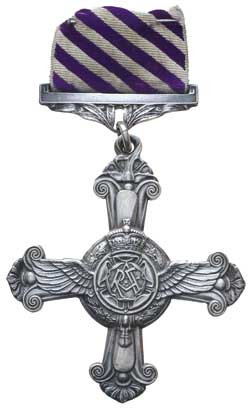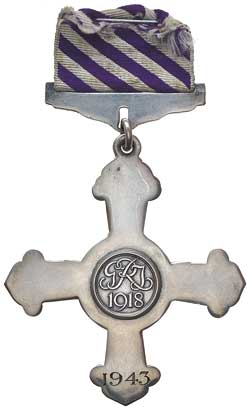New Zealand Medals
Lot 5684 Session 18 (2.30pm Friday) New Zealand Medals
Estimate $5,000
Bid at live.noble.com.au
SOLD $6,500
DISTINGUISHED FLYING CROSS (GVIR) (GRI FIRST TYPE), 1943 engraved on reverse lower arm of cross; award ribbons for Distinguished Flying Cross, 1939-45 Star, Air Crew Europe Star; Africa Star, Defence Medal 1939-45, War Medal 1939-45 with MID emblem, New Zealand War Service Medal 1939-45 all attached to RNZAF dress jacket with embroidered WWII issue RNZAF pilot's wings above. The cross engraved. The lining inside the jacket torn in parts, fine, the cross in case of issue, this damaged and with recipient's daughter's initials DH in ink on lid lining, no top pin-back suspension bar, cross extremely fine.
Together with Mention in Despatches certificate signed by Sir Archibald Sinclair, Secretary of State for Air and embroidered WWII RNZAF pilot's wings both in frame; Letter (marked Duplicate) from Central Chancery of the Orders of Knighthood requesting attendance at Buckingham Palace on 2 November 1943 for presentation of DFC; Pilot's flying log books (3) includes training log book 1939 (this has also been used by FLTLT Henry post war (1948) to record race horse results in New Zealand, also contains children's scribble from his daughter), Royal N.Z. Air Force log book 1939 - 1943 and Royal Air Force log book 1943 - 1945 and post war 1948 - 1953; Bag the Hun! an official training exercise book issued by the Air Ministry in April 1943 as training instruction guide to improve pilot's shooting skills in the air; note book made by FLTLT Henry while a prisoner-of-war using a Sugar Drop Prunes packet (ex Red Cross food parcel) as the cover and the binding fashioned from a thread pulled from his clothing to hold it together, includes diary of his operations leading up to his having to bale out, his capture and experiences as a POW, also war related poem by Noel Coward, the Air Corps song, Wings over the Navy song and names and civilian addresses of other Commonwealth and American POW service personnel (the book also has some of his daughter's childhood scribble); photos (3); copy of letter dated 14 August 1963 from an American recalling time spent in POW camp with FLLT Henry; R.N.Z.A.F. Posting Instruction form following WWII; various research papers. Squadron Leader David John Verdun Henry NZ40229 & 130327 DFC LG 25/5/1943:2321 Citation: 93 Sqn RAF (Spitfire) `Flight Lieutenant Henry has shown outstanding keenness and initiative in organising operations which has caused much destruction among enemy ground forces and airfields. He has destroyed one enemy aircraft in the air and probably destroyed another, while several have been damaged. He has also secured valuable information about troop movements. Flight Lieutenant Henry's gallantry and determination have always been of the highest order.' Mention in Despatches 2/6/1943 Citation: `Flight Lieutenant Henry has shown outstanding keenness and initiative in organizing operations which have caused much destruction among enemy ground forces and airfields. He has displayed gallantry and determination which has always been of the highest order.' David John Verdun Henry was born on 5 December 1916 at Invercargill, New Zealand. Known to his family and friends as Jack, he underwent Civil Reserve flying training with the Southland Flying Club from 26 June - 11 September 1939. He then enlisted into RNZAF on 15 January 1940 and commenced flying training on 15 February 1940 with No.1 EFTS (Elementary Flying Training School). He then underwent further pilot training until 27 November 1941 flying a variety of aircraft at No 1 FTS Wigram, ATS No 1 FTS Wigram, ATS No 2 FTS Woodbourne, No 3 FTS Ohakea and FTS Hobsonville. During this period Jack Henry was commissioned on 27 July 1940 and promoted to Flying Officer on 27 July 1941 On 25 February 1942 he was posted to Polbrook Op Sqn and then from 15 March 1942 - 9 May 1942 at Alston Down with No 52 OTU training on Spitfire, Miles Master and Wellington. He was posted to No 485 Sqn (NZ) based at Kenley from 10 May 1942 - 8 July 1942 being promoted to Flight Lieutenant on 27 July 1942. Recorded in his log book is a report from his CO, S/L R J C Grant, `F/Lt Henry has been with me some time now and has had considerable fighting experience. I have always found him hard working, keen and conscientious and definitely above the average as a pilot and leader.' Jack Henry's daughter said that her father's nickname was `Sheep' because he was from New Zealand which of course is famous for its large number of sheep. From 8 July 1942 - 30 November 1942 FLTLT Henry was based at Kings Cliffe, Northhamptonshire for operations over France and Germany. After this he moved to Souk-El-Arba Airfield, Tunisia as OC `B' Flight. Noted in his log book, `7/5/43 Tunis Fell Today - Army marched in 10.30AM.' On 7 June 1943 Jack was attached to 324 Wing pending posting and he noted in his log book, `Awarded DFC, Mention in Despatches'. In October 1943 he undertook further training on No 35 Course at Central Flying School (Gunnery) at Sutton Bridge. From then until October 1943 he was engaged on operations flying Diver Patrols chasing down `Doodle Bugs' (V-1 flying bombs) heading for England and also other operational sorties over Europe. In November 1943 he was in London to attend Buckingham Palace for presentation of his DFC by King George VI. In April 1944 until end of June 1944 he was based in Canada at Rockcliffe Airport and was promoted to Acting Squadron Leader on 1 April 1944. In August 1944 he was posted to 130 Sqn at RAF Tangmere flying the Spitfire XIV and at the end of that month he was posted to 41 Sqn as Flight Commander flying the Spitfire XII. During one of his operations on 9 September 1944 he has recorded in his log book, `Brussells (sic) Airfield - Pranged on landing. Forehead lacerated. Tyre burst on landing Spit went up on its nose'. On 10 February 1945, while commanding an operational flight to Osnabruck, Dummer Lake, Rheine Area, FLTLT `Jack' Henry failed to return. The following details were recorded in his log book by one of his squadron members. `Damaged One Loco. F/Lt Henry Did Not Return. Blue Section Of Aircraft attacked a locomotive in the vicinity of Dummer Lake. F/Lt Henry was the first to attack and was greeted by heavy flak. He continued to attack the loco and was seen to damage it. As he pulled up white vapour streamed from the a/c and he said his a/c was hit. He tuned towards home but his engine seized and he baled out in the vicinity of Rheine. He was last seen gliding down towards the clouds at a height of 3000 feet. Taken POW after baling out. Escaped from forced march to Munich. Returned England 19 April 1945.' In Jack Henry's personal diary written while a POW he recorded, `..No cockpit. Climbed on to the wing at 2,000 ft & next moment I hit the silk. A nasty jolt and DJV was floating to earth by parachute for the first time in his flying career (1939). I watched my A/C crash & burst into flames & next moment I was sprawling and being dragged through small shrubbery. Pleased I set ???? from A/C across open fields but was shortly accosted by one of the Wehrmacht. I was calm by this time but still could not believe I was a captive in German hands & would not be going back to my comfortable bed & quarters at home. And so after 5 years of aviating I now find myself with wings clipped & heading for a POW Camp.' Jack finally was imprisoned at Stalag 13 Langwasser, Nuremberg POW camp. During interrogation he was locked in a cold room with a drip of water landing at regular intervals on his forehead. He was offered a warm shower and nice food in exchange for information but he refused to talk. As the allies advanced Jack noted that the Germans were determined to retain POWs so they started to march them to Munich and it was during this forced march that Jack managed to escape on 4 April 1945. He then has recorded in his POW diary, `16/4/45 Glory Be! We are free and the Yanks are Great Boys! Best meal & loads of cigarettes. We have just walked into our lines.' Following his escape he returned to his squadron at Tangmere on 12 May 1945. Post war Jack Henry was placed on the Reserve of Officers on 28 November 1945. On 18 March 1948 he was entitled to relinquish his commission and he then continued flying in New Zealand in the Active Reserve from 1/8/48 - 26/8/53. Jack Henry's brother, FLTLT Colin Hayes Henry (12 Sqn RAF [Lancaster] pilot and captain, 32 sorties) was also awarded the Distinguished Flying Cross on 27 March 1945. Squadron Leader `Jack' David John Verdun Henry died at Invercargill on 7 August 1984. His daughter has no knowledge of his standard campaign and service medals, all of which would be unnamed as is the normal mode of issue by the New Zealand authorities, and she has no recollection of ever seeing her father wearing them.
Estimate / sale price does not include buyer's premium (currently 22% including GST) which is added to hammer price. All bids are executed on the understanding that the Terms & Conditions of sale have been read and accepted. For information on grading and estimates please refer to the Buying at Auction advice.
Quick find
View a lot by number and sale.
Adjacent lots
Lot 5682
PAIR: British War Medal 1914-18; Victory Medal 1914-19. 60454 Pte. F.P. Wilkie. N.Z.E.F. Impressed. Very ...
Estimate $120
Lot 5683
PAIR: British War Medal 1914-18; Victory Medal 1914-19. 63465 Pte. R. Wilson. N.Z.E.F. Impressed. Very ...
Estimate $200
Lot 5684 This lot
DISTINGUISHED FLYING CROSS (GVIR) (GRI FIRST TYPE), 1943 engraved on reverse lower arm of cross; ...
Estimate $5,000
Lot 5685
AUSTRIA, Medal for Bravery, bronze, Karl I issue 1917-18, Signum Memoriae Medal 1898; Germany, WWI ...
Estimate $70
Lot 5686
FRANCE, Croix de Guerre, 1914-16; Third Republic, Medaille Militaire; Germany, Prussia, WWI War Merit Kriegs ...
Estimate $150

